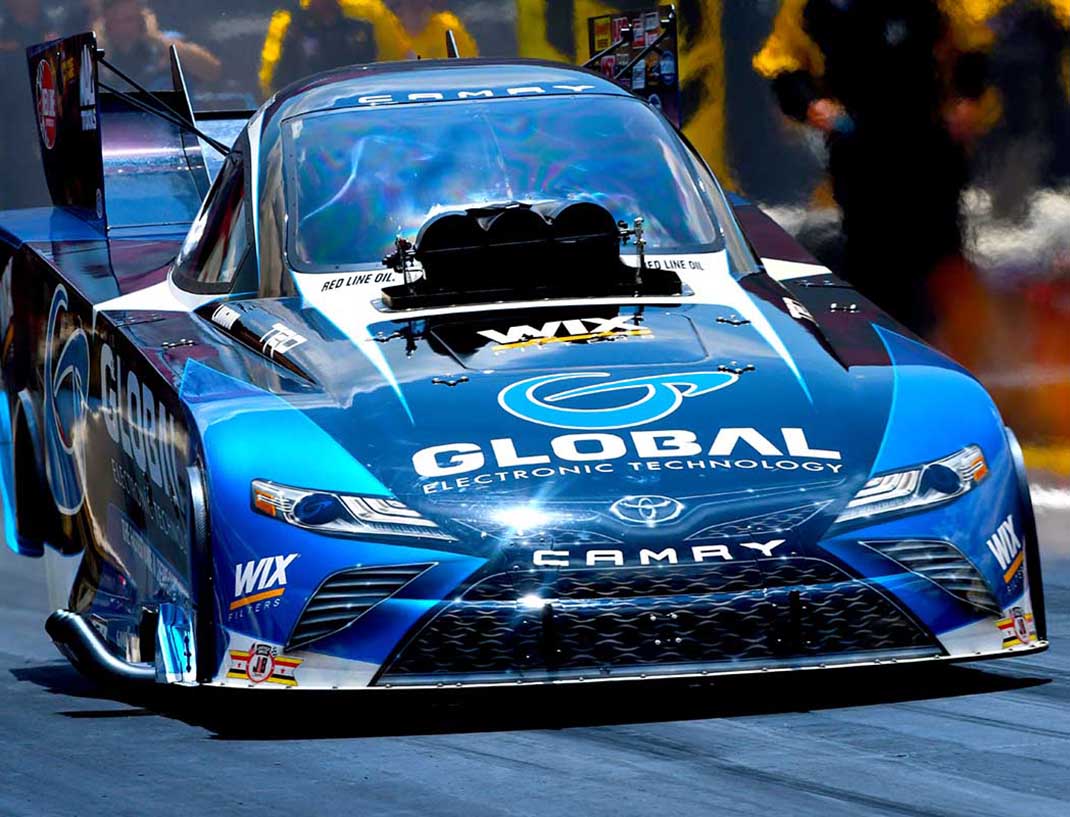It’s selling the sizzle along with the steak, and the Funny Car class has plenty of sizzle these days. TRD is the grill master.
For example, Pierce said, “We’re planning to continue with the Camry body. We’re looking at options now for a new body of the Camry style. We plan to introduce that in 2021. There’s a lot that has to go into the engineering. In a sport that in a thousandth of a second you can win or lose, there’s a lot of thought that goes into the aerodynamics and the weight distribution of those vehicles.”
NHRA has mandated that Funny car bodies must be styled resembling a 1991-or-later two-door coupe or sedan. Toyota’s approach is no different than its three rivals.
Pierce alluded to the specs and parameters the NHRA sets for a Funny Car body. After satisfying those, engineers “look at all pieces of the car” to determine what styling options they have to tweak for performance.
Pierce said the TRD engineering group works across the motorsports spectrum to find every performance advantage.
“Maybe they go from something they learned in NHRA and they could potentially take it and use that in NASCAR,” Pierce said. “So they’re looking across different motorsports. And eventually they can take that and maybe, potentially, use that in production cars, the stuff we learn on track. At the end of the day, I think it’s a passion for cars.
“We have a passion to make great vehicles that people can drive on the road, from a safety, quality and budget perspective. And we want to do the same thing on the track: We want to have the best performance, the most competitive vehicles. That translates both ways, from on track to on the road.”

TRD only started supporting NHRA drag racing in the past two or three years. Kalitta Motorsports built its Funny Car and one iteration sits at the North Carolina TRD headquarters, where engineers from various series, most notably NASCAR, can examine it closely to deliberate what advances they might be able to introduce. They can study downforce and the effects that various parts might have on function. Pierce labeled it “bringing a diverse perspective of thinking.”
Richard “Slugger” Labbe, a former NASCAR tuner who has been with TRD for a couple of seasons, said, “So now I can take engineers out and show them different parts and pieces. We get to show them what we’re working on and what we’re looking to work on for future development. We’re just trying to get them to victory circle as fast as we can.”
To do that, Pierce said, “We really partner with the teams. We don’t just give cash support. We’re actively involved. The relationship we have is first-name basis. We talk on the side in the offseason,” she said. “I’ve heard repeatedly from the drivers what a great partner Toyota is. It’s very rewarding to hear how well-respected we are in the industry.”
Chevrolet has a big stake throughout all levels of the NHRA. Dominick said Chevy might have a limited presence in Funny Car, but it has the premier driver and team owner: “We are fortunate enough to be partnered with John Force Racing. Even if you don’t know drag racing, you do know John Force.
“Chevrolet has a great commitment to NHRA,” Dominick continued. “We will try to work with them to make the sport even better. But you see the trajectory of NHRA just continue to go up. It’s a constant rise. It’s not a ‘blown-out-of-the-cannon and then how do you sustain that?’ They continue to build it, and they build it at a rate that’s consumable.”
And Chevy has a strong presence on the midway, the fans’ avenue between the grandstands and pits. Ford sponsors the Y.E.S. Program, using the partnership with the sport to recruit technicians.
Toyota also has an elaborate, hands-on display. Both Dominick and Pierce tout their brands’ showroom-away-from-a-showroom setups.
“We’re able to display our vehicles,” Pierce said. “It’s a really cool way for fans of the sport to be able to get in our car, look at it and talk to a product specialist about it without having to go to a showroom. Sometimes people feel intimidated at a dealership. It’s a neat way to experience our cars. We have great ambassadors who come to the track with us. We have a diverse fan base. NHRA has a unique fan base — they’re very loyal. And we love having them come and interact with us at the race track.”
Each automaker has its reasons and its angles for participating, but Beahm has a fresh perspective. The head of parts and service and passenger-car brands for Fiat Chrysler Automobiles said, “Your fingers are different sizes and they’re different lengths. That’s what makes a good team.”
That proved correct when the 2018 season finale began last November. The top four racers still in the championship hunt represented four different automakers. Eventual champion J.R. Todd carried the Toyota banner with his Kalitta Motorsports Camry. Hot on his heels was Camaro driver Robert Hight. Hoping to give Dodge another Funny Car title was Ron Capps, and Tim Wilkerson was in fourth place with his Ford Mustang. Tommy Johnson Jr. slipped into the No. 3 spot in the final standings with his Dodge.
It was a balanced performance by all four manufacturers.
